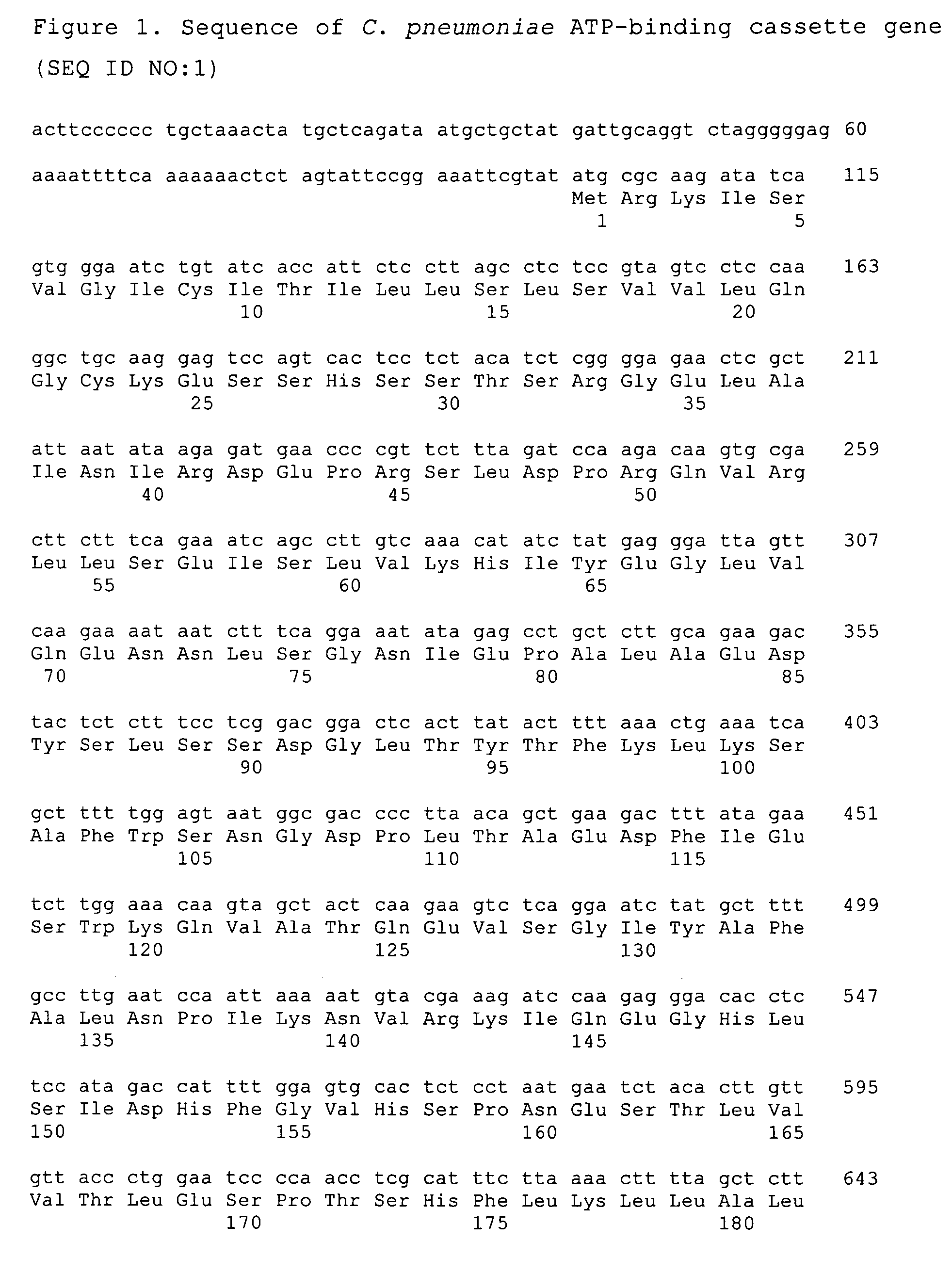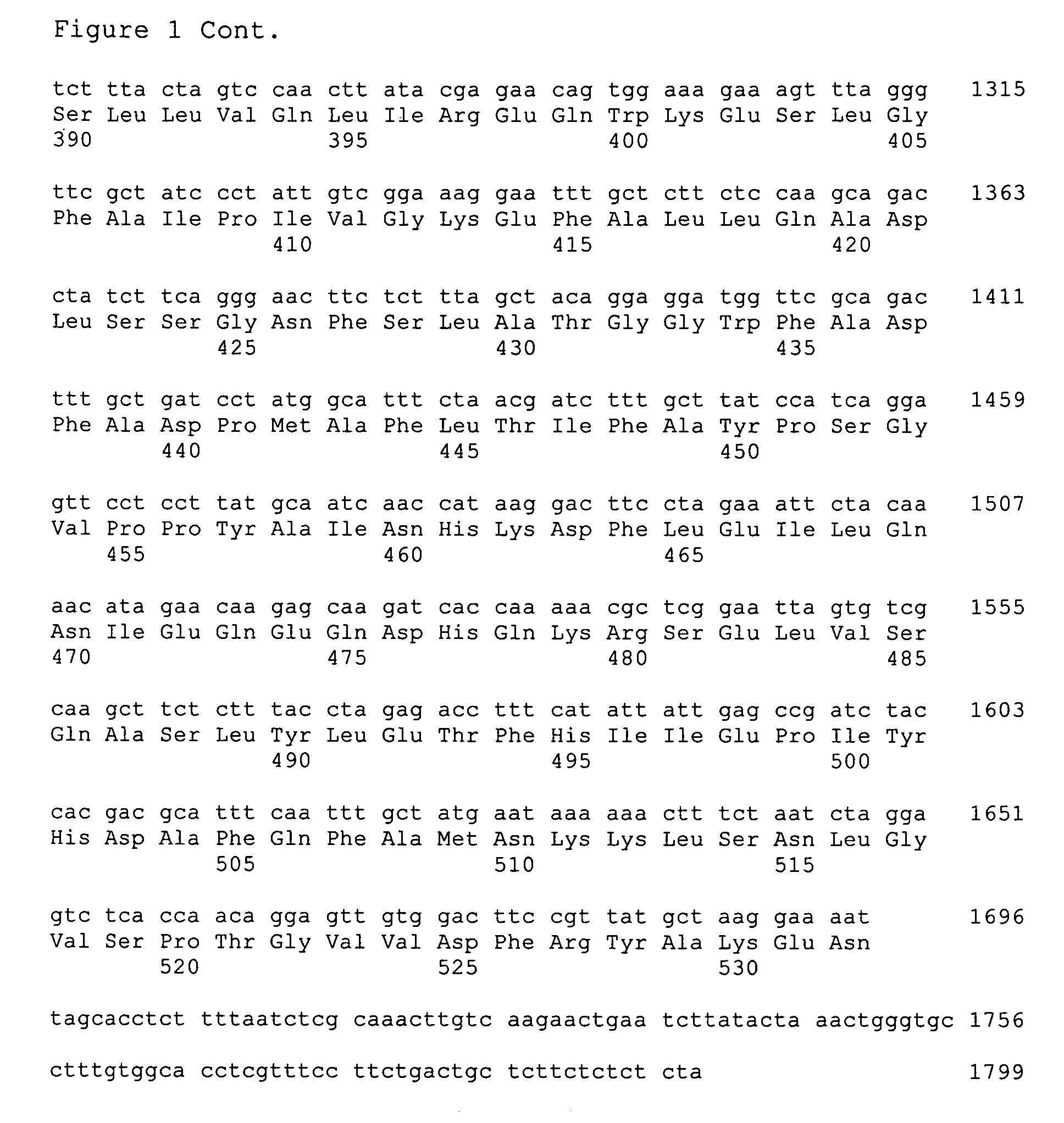Chlamydia antigens and corresponding DNA fragments and uses thereof
a technology of chlamydia and atpbinding cassette, which is applied in the field of chlamydia atpbinding cassette and corresponding dna molecules, can solve the problems of chlamydia /i>infection, vaccine safety margin not high enough, and not yet an effective vaccine for any human
- Summary
- Abstract
- Description
- Claims
- Application Information
AI Technical Summary
Problems solved by technology
Method used
Image
Examples
example 1
[0150]This example illustrates the preparation of plasmid vector pCACPNM209 containing the ATP-binding cassette gene.
[0151]The ATP-binding cassette gene was amplified from Chlamydia pneumoniae genomic DNA strain CWLO29 by polymerase chain reaction (PCR) using a 5′ primer (5′ ATAAGAATGCGGCCGCCACCATGCGCAAGATATCAGTGGGAATC 3′; SEQ ID No: 3) and a 3′ primer (5′ GCGCCGGATCCCATTTTCCTTAGCATAACGGAAGTCC 3′; SEQ ID No: 4). The 5′ primer contains a NotI restriction site, a ribosome binding site, an initiation codon and a sequence at the 5′ end of the ATP-binding cassette coding sequence. The 3′ primer includes the sequence encoding the C-terminal sequence of the ATP-binding cassette gene and a BamHI restriction site. The stop codon was excluded and an additional nucleotide was inserted to obtain an in-frame fusion with the Histidine tag.
[0152]After amplification, the PCR fragment was purified using QIAquick™ PCR purification kit (Qiagen), digested with NotI and BamHI and cloned into the pCA-Myc...
example 2
[0153]This example illustrates the preparation of the eukaryotic expression vector pCA / Myc-His.
[0154]Plasmid pcDNA3.1(−)Myc-His C (Invitrogen) was restricted with SpeI and BamHI to remove the CMV promoter and the remaining vector fragment was isolated. The CMV promoter and intron A from plasmid VR-1012 (Vical) was isolated on a SpeI / BamHI fragment. The fragments were ligated together to produce plasmid pCA / Myc-His. The NotI / BamHI restricted PCR fragment containing the ATP-binding cassette gene was ligated into the NotI and BamHI restricted plasmid pCA / Myc-His to produce plasmid pCACPNM209 (FIG. 3).
[0155]The resulting plasmid, pCACPNM209, was transferred by electroporation into E. coli XL-1 blue (Stratagene) which was grown in LB broth containing 50 μg / ml carbenicillin. The plasmid was isolated by the Endo Free Plasmid Giga Kit™ (Qiagen) large scale DNA purification system. DNA concentration was determined by absorbance at 260 nm and the plasmid was verified after gel electrophoresis...
example 3
[0156]This example illustrates the immunization of mice to achieve protection against an intranasal challenge of C. pneumoniae.
[0157]It has been previously demonstrated (Yang et al. Infect. Immun. May 1993. 61(5):2037–40) that mice are susceptible to intranasal infection with different isolates of C. pneumoniae. Strain AR-39 (Grayston et al (1990) Journal of Infectious Diseases 161:618–625) was used in Balb / c mice as a challenge infection model to examine the capacity of Chlamydia gene products delivered as naked DNA to elicit a protective response against a sublethal C. pneumoniae lung infection. Protective immunity is defined as an accelerated clearance of pulmonary infection.
[0158]Groups of 7 to 9 week old male Balb / c mice (8 to 10 per group) were immunized intramuscularly (i.m.) plus intranasally (i.n.) with plasmid DNA containing the C. pneumoniae ATP-binding cassette gene as described in Examples 1 and 2. Saline or the plasmid vector lacking an inserted Chlamydial gene was gi...
PUM
| Property | Measurement | Unit |
|---|---|---|
| Tm | aaaaa | aaaaa |
| temperature | aaaaa | aaaaa |
| temperatures | aaaaa | aaaaa |
Abstract
Description
Claims
Application Information
 Login to View More
Login to View More - R&D
- Intellectual Property
- Life Sciences
- Materials
- Tech Scout
- Unparalleled Data Quality
- Higher Quality Content
- 60% Fewer Hallucinations
Browse by: Latest US Patents, China's latest patents, Technical Efficacy Thesaurus, Application Domain, Technology Topic, Popular Technical Reports.
© 2025 PatSnap. All rights reserved.Legal|Privacy policy|Modern Slavery Act Transparency Statement|Sitemap|About US| Contact US: help@patsnap.com



